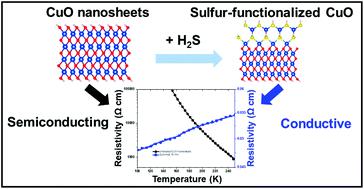Our official English website, www.x-mol.net, welcomes your feedback! (Note: you will need to create a separate account there.)
Semiconductor-to-conductor transition in 2D copper(ii) oxide nanosheets through surface sulfur-functionalization.
Nanoscale ( IF 6.7 ) Pub Date : 2020-06-26 , DOI: 10.1039/d0nr02208j Matthew J Montgomery 1 , Nikita V Sugak , Ke R Yang , James M Rogers , Sebastian A Kube , Anthony C Ratinov , Jan Schroers , Victor S Batista , Lisa D Pfefferle
Nanoscale ( IF 6.7 ) Pub Date : 2020-06-26 , DOI: 10.1039/d0nr02208j Matthew J Montgomery 1 , Nikita V Sugak , Ke R Yang , James M Rogers , Sebastian A Kube , Anthony C Ratinov , Jan Schroers , Victor S Batista , Lisa D Pfefferle
Affiliation

|
Functionalization is a widely-used strategy to modulate and optimize the properties of materials towards various applications, including sensing, catalysis, and energy generation. While the influence of sulfur-functionalization of carbon materials and oxides like ZnO and TiO2 has been studied, far less research has been devoted to analyzing sulfur-functionalization of CuO and other transition metal oxide nanomaterials. Here, we report sulfur-functionalization of copper(II) oxide nanosheets synthesized by using a soft-templating procedure, with sulfur-addition based on hydrogen sulfide gas as a source. The resulting sulfur-functionalization does not change the overall crystal structure and morphology of the CuO nanosheets, but leads to a decrease in surface hydroxyl groups. Sulfur induces a semiconductor-to-conductor state transition of the CuO nanosheets, which is supported by computational modeling. The metallic transition results from shifting of the Fermi level into the valence band due to formation of Cu–S bonds on the surface of the CuO nanosheets.
中文翻译:

通过表面硫官能化,二维铜(ii)氧化物纳米片中的半导体到导体的转变。
功能化是一种广泛使用的策略,可针对各种应用来调制和优化材料的特性,包括传感,催化和能量产生。虽然已经研究了碳材料和诸如ZnO和TiO 2的氧化物的硫官能化的影响,但很少有研究致力于分析CuO和其他过渡金属氧化物纳米材料的硫官能化。在这里,我们报告的铜硫官能(II)通过使用软模板程序合成的氧化物纳米片,并以硫化氢气体为源添加了硫。所得的硫官能化不会改变CuO纳米片的整体晶体结构和形态,但会导致表面羟基的减少。硫诱导了CuO纳米片的半导体到导体的状态转变,这由计算模型支持。金属过渡是由于在CuO纳米片表面上形成Cu–S键,使费米能级移至价带。
更新日期:2020-07-16
中文翻译:

通过表面硫官能化,二维铜(ii)氧化物纳米片中的半导体到导体的转变。
功能化是一种广泛使用的策略,可针对各种应用来调制和优化材料的特性,包括传感,催化和能量产生。虽然已经研究了碳材料和诸如ZnO和TiO 2的氧化物的硫官能化的影响,但很少有研究致力于分析CuO和其他过渡金属氧化物纳米材料的硫官能化。在这里,我们报告的铜硫官能(II)通过使用软模板程序合成的氧化物纳米片,并以硫化氢气体为源添加了硫。所得的硫官能化不会改变CuO纳米片的整体晶体结构和形态,但会导致表面羟基的减少。硫诱导了CuO纳米片的半导体到导体的状态转变,这由计算模型支持。金属过渡是由于在CuO纳米片表面上形成Cu–S键,使费米能级移至价带。


























 京公网安备 11010802027423号
京公网安备 11010802027423号